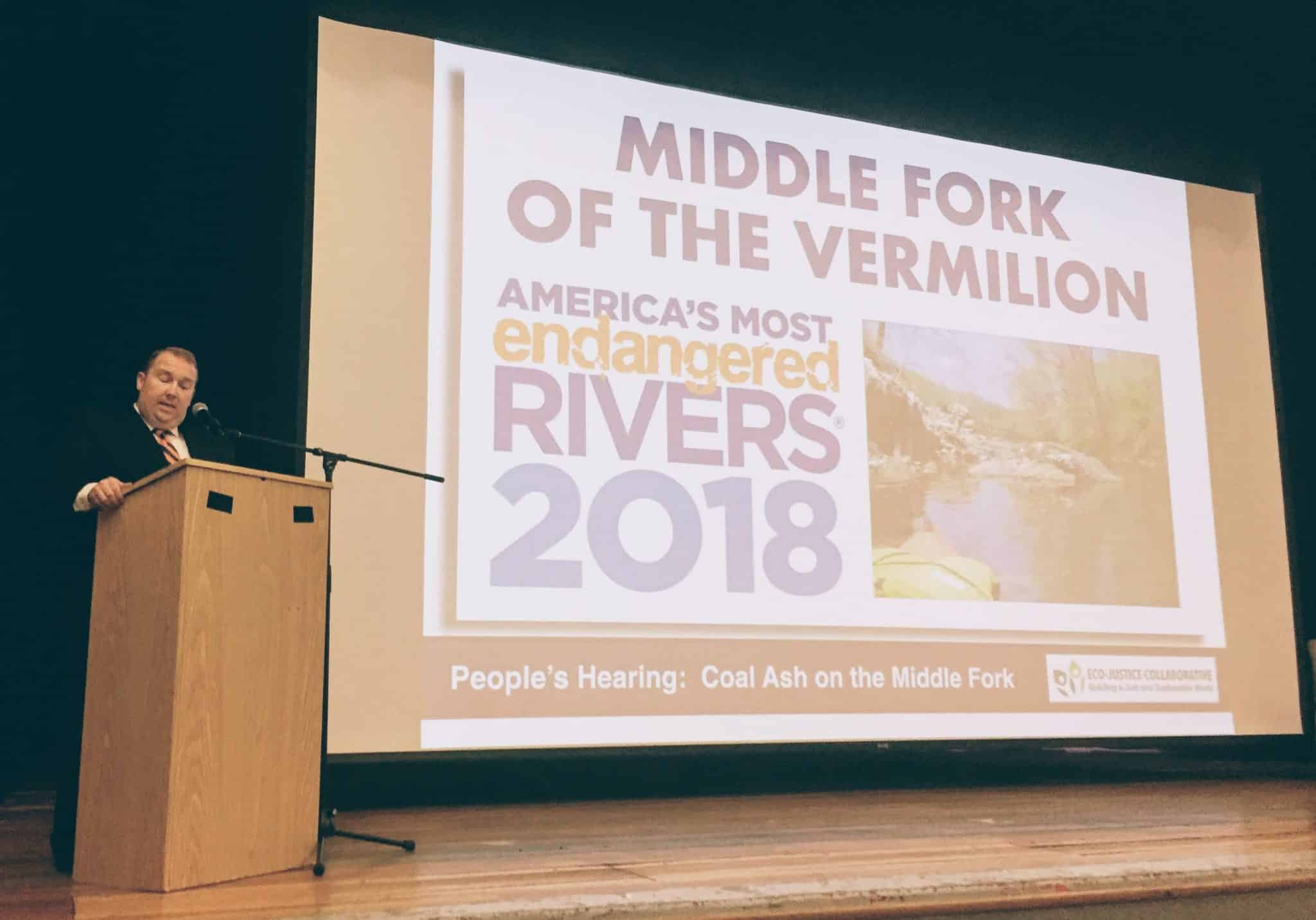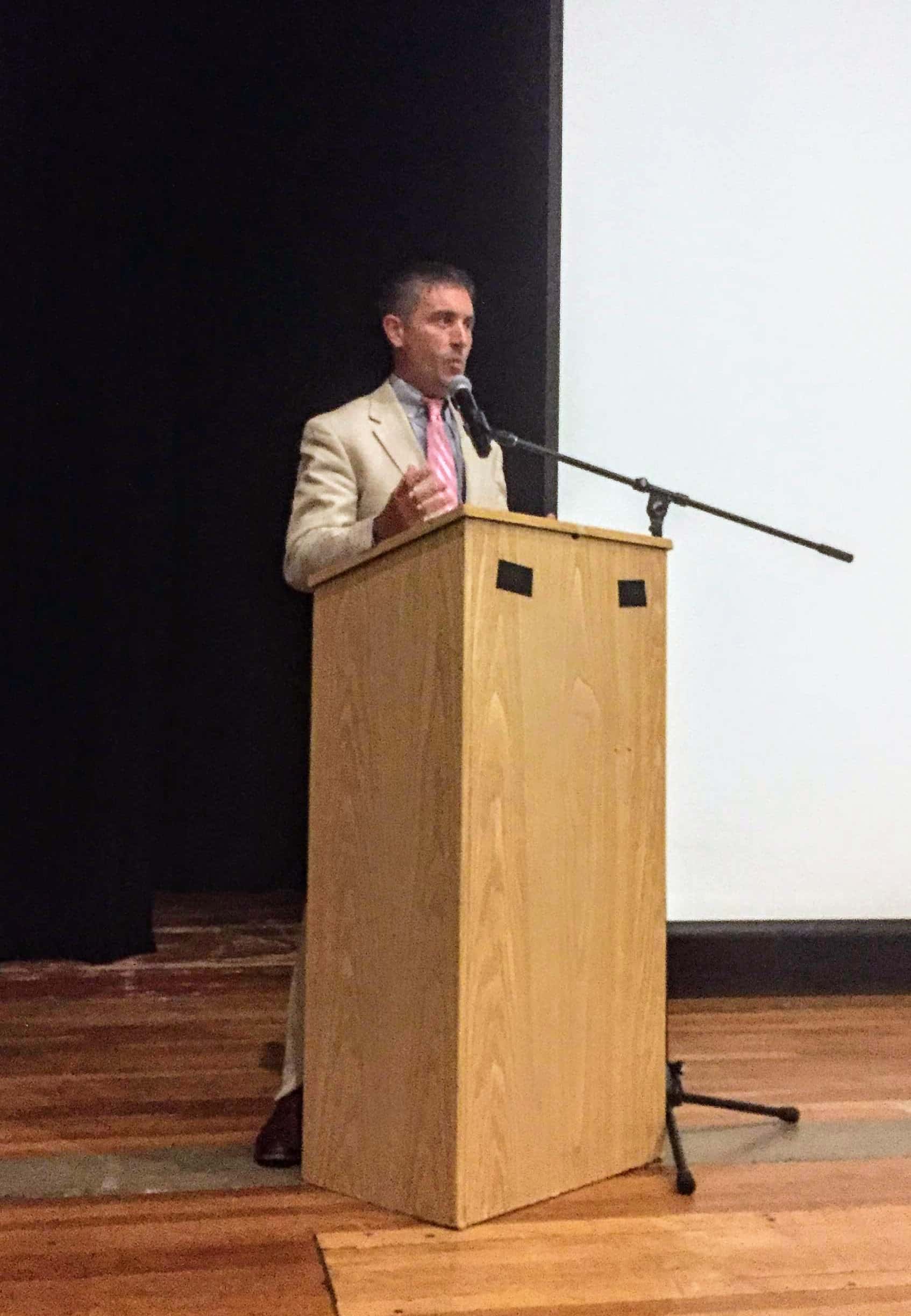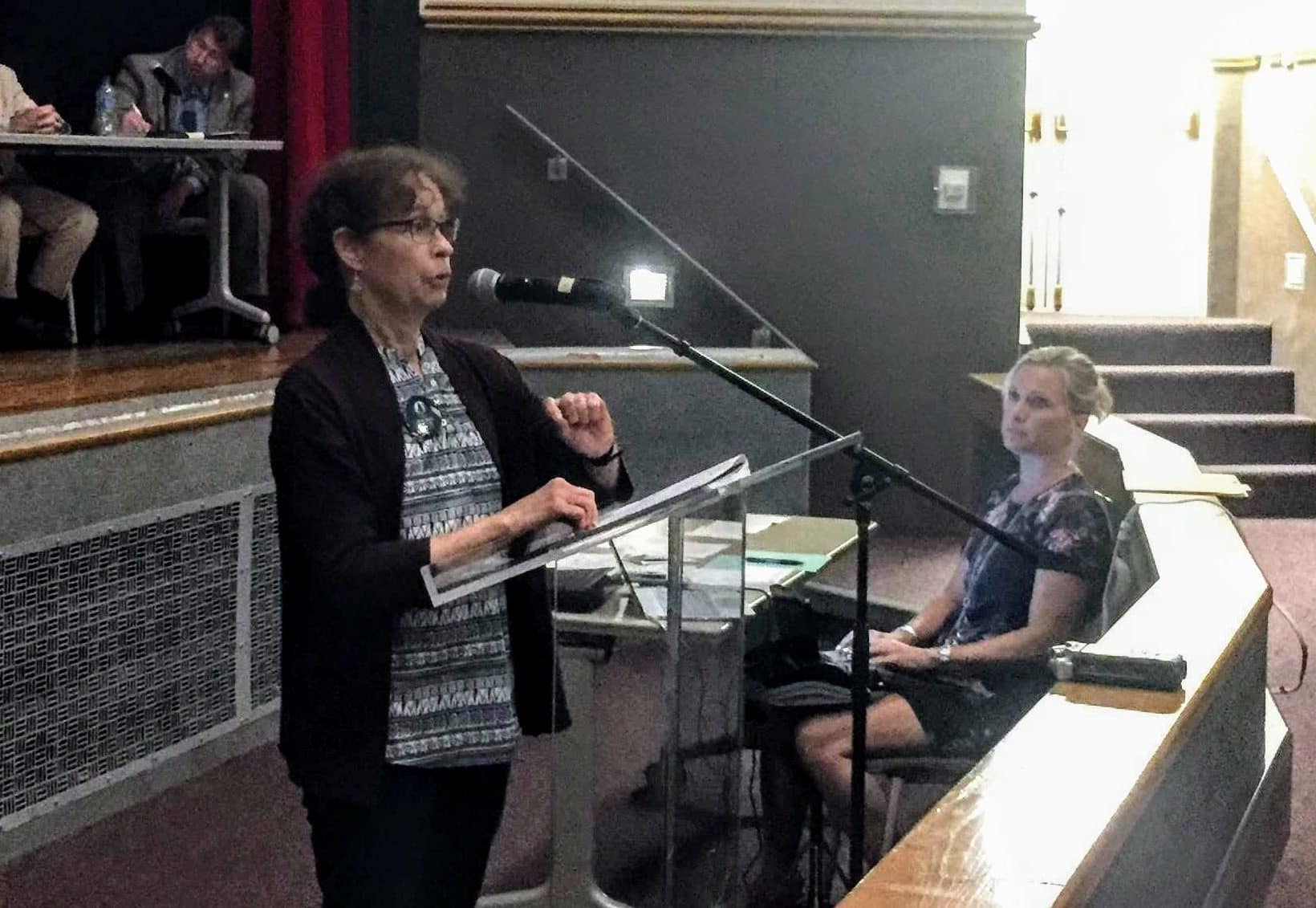On Monday, June 11th, well over 100 members of the public and a panel of experts gathered in the Bremer Auditorium of the Danville Community College to attend the People’s Hearing to Protect the Middle Fork. Organized by Eco-Justice Collaborative, the People’s Hearing was intended to give the citizens of Vermilion County and beyond a chance to speak up for the Middle Fork river. The hearing was chaired by Senator Scott Bennett, Vermilion County Board Chair Mike Marron, and Danville Mayor Scott Eisenhauer.

The People’s Hearing began with a brief presentation from Pam Richart of Eco-Justice Collaborative. She explained the situation — there are three huge coal ash pits sitting on the bank of the Middle Fork river, Illinois’ only National Scenic River. The coal ash is leaching toxic contaminants into the river and an eroding river bank threatens the stability of the impoundment levee. The coal ash is owned by Dynegy (recently purchased by Vistra), who wants to close the impoundments and be done with them. The purpose of the People’s Hearing was to provide the public a space to hear from experts and comment on the closure plans for the coal ash pits, the plans that will decide their permanent fate. Will the toxic coal ash be left in the floodplain or should it be removed? Richart then introduced the speakers for the night.
The first expert to speak was Illinois EPA’s Rick Cobb, Deputy Division Manager of the Division of Public Water Supplies, to talk about the regulatory process. Illinois EPA sent Dynegy a notice of groundwater violation in 2012. Cobb explained how we got from that notice letter to now, and what they’re expecting from Dynegy/Vistra next — a groundwater analysis and closure plan proposal in October. Cobb “used the P word,” perpetuity, emphasizing that Dynegy’s solution needs to work in perpetuity.
Next up was Rob Kanter, writer of the weekly Environmental Almanac, PRN board member, and Middle Fork enthusiast. Kanter set the scene, sharing why the Middle Fork is a special place to so many people. He shared images of the wildlife that call the river home and the fun activities that draws people to the river. The Middle Fork was designated as a National Scenic River to protect the river for future generations of both people and wildlife.
To share information about the dangers of coal ash, Eco-Justice Collaborative played a pre-recorded interview with Abel Russ, an attorney with the Environmental Integrity Project. He explained the research that shows coal ash is a problem. Russ made points about the environmental and health risks in coal ash, and he touched on the problems that can come with capping and leaving a coal ash impoundment instead of cleaning the coal ash up.

Vermilion County Board Chair Mike Marron and Danville Mayor Scott Eisenhauer spoke to the economic value of the river. Marron showed that the Middle Fork is the cornerstone of economic development plans for Vermilion County, which draws in visitors with its many beautiful parks and naturals paces. He also shared his fond memories of the river, showing that the Middle Fork is personally important to him, as it is for many of us.
Speaking for Danville, Mayor Eisenhauer talked about the city’s plans to develop their riverfront, creating new economic opportunities and becoming a regional attraction. Danville is just downstream of the Middle Fork. To the Mayor, an environmental liability on the Middle Fork could sink their riverfront development plan, and he called for Dynegy/Vistra to take responsibility for their mess and move their coal ash out of the floodplain of the river.
Prairie River Network’s Andrew Rehn spoke about the documented groundwater contamination at the site and how the contaminated groundwater is seeping through the riverbanks into the Middle Fork. He also talked about the closure plans that Dynegy has proposed so far and what we are expecting from the next round of closure plans.
Professor Bruce Rhoads, a fluvial geomorphologist1 from the University of Illinois explained how river meandering works. He showed that the Middle Fork is a naturally meandering river and provided evidence that the river was once flowing through the part of the floodplain that later became one of the ash pits. He concluded by saying that from the perspective of geological time, the river is going to retake the floodplain from the coal ash pits. The only question is how long until that happens.
Mike Dudas of Dudas Engineering talked about the structural stability issue, the history of construction at the site, and the threat a meandering river can pose to the stability of those impoundments.
The expert portion of the People’s Hearing closed with testimony from Sarah McCoin, who was impacted by the TVA Kingston disaster in Tennessee, where a dam containing a coal ash pit ruptured and over 1 billion gallons of coal ash spilled onto people’s homes and land. She shared her first-hand experience of dealing with a coal ash disaster and the challenges of dealing with the company that caused the disaster.

We then heard from the general public, giving anyone who attended the hearing a chance to speak. The message was resoundingly clear — the Middle Fork is a precious resource, and the people don’t trust Dynegy to do the right thing. They want more out of their government regulators to protect them from Dynegy’s coal ash waste and hold Dynegy accountable to their mess. The Middle Fork is the people’s river, and they want to see it protected.
A representative from Vistra (who recently purchased Dynegy) was present and submitted written comments.
Thanks to Eco-Justice Collaborative for all the work they put into this event, and to Senator Bennett for facilitating the discussion.
1. Fluvial – “of or found in a river”. Ge/geo – “earth”. Morphology – “the study of form”.
Fluvial Geomorphology – the study of the shapes of river channels and how they change in shape and direction over time.







